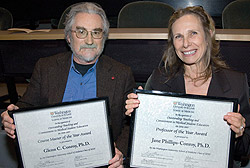His modest demeanor provides little hint of neither his brilliant career nor the ivy-paved path that serendipitously led him to Washington University in St. Louis more than 20 years ago.
 |
|
|
|
More than 20 years ago, Glenn Conroy, professor of anatomy and of anthropology, was lured to the School of Medicine by radiologists who were using computed tomography to digitally reveal bones hidden under layers of skin and tissue. Conroy, an expert in human anatomy and evolution, applied the same techniques to his anthropological research, and a display of his work can be found at the Farrell Learning and Teaching Center.
|
A renowned anthropologist, Glenn Conroy, Ph.D., has been gathering valuable fossil remains of humans and non-human primates for more than 30 years. Some of his best work is on display through January in the Farrell Learning and Teaching Center (See it now).
“I’ve been involved in a number of paleoanthropological expeditions around the world,” he says. “My own particular interest is human evolution and even non-human primate evolution. I’ve been studying the evolution of humans and non-human primates that go back over the last 70 million years or so in time.”
So, how is it that his primary teaching responsibility introduces him to all first-year medical students at the University?
“I always thought that biological anthropology was a very nice way to try to understand the human condition,” Conroy says, “because you deal with it from both a biological perspective and an evolutionary perspective — as well as a social and cultural perspective.”
Conroy, professor of anatomy and neurobiology and of anthropology, serves as the course master for human anatomy — an important first-year requisite for medical students.
A biological anthropology student himself, Conroy graduated from the University of California at Berkley in the 1960’s — “interesting times,” he recounts — then earned his Ph.D. from Yale.
His first teaching position was at New York University, and he was later an anthropology professor at Brown University before deciding to join Washington University in 1984.

“While I was still at Brown, I happened to see an article in a newspaper. I was in a grocery store and saw a cover of a (three-dimensional computed tomography) image of a skull, and I thought that looked pretty interesting, being an anthropologist. But I thought it was just an image of a skull until I looked inside and saw that it was an image of an actual living child where electronically doctors had removed the skin and soft tissue from the bone so they could examine the bones before they planned the surgery.
“So this light bulb went off in my head. … I thought that if you could begin to electronically remove aspects of a skull in living persons, why couldn’t we do that with fossils.”
Being able to study a fossilized skull without destroying it has always been a major obstacle to anthropologists. Often, a fossil skull is encased in a rock-hard matrix or the brain cavity is filled with stone.
So began the convergence of medical technology and physical anthropology for Conroy. He and his wife, Jane Phillips-Conroy, Ph.D., also an accomplished anthropologist, decided to move their teaching and research careers from Brown to Washington University, where these groundbreaking CT techniques were being developed.
“The anatomy department here has a long history of being involved in physical anthropology. I already had tenure at Brown. I had no thought at all of ever leaving. We were just so excited about everything going on here at Washington University School of Medicine and about the connections between anthropology and anatomy. It was very exciting to come here.”